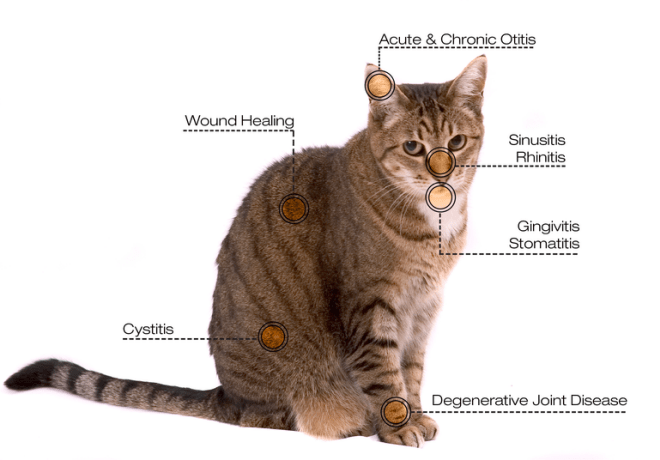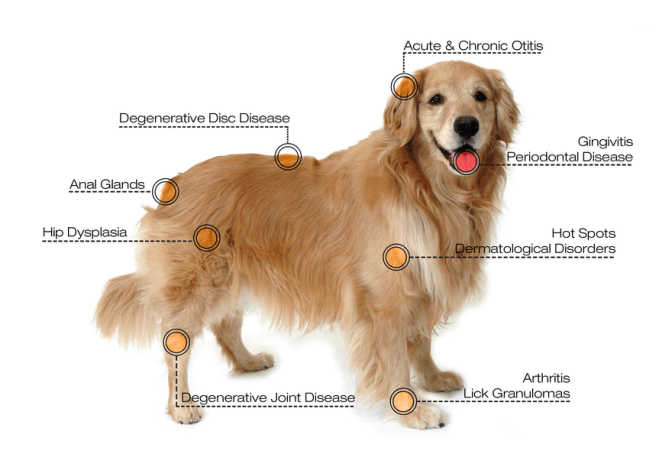Veterinary Laser Treatment for Various Kinds of Animals
Surgical lasers have become a very important part of Veterinary medicine. The advent of the surgical laser has improved the treatment of many disease states previously treated with a scalpel or electrosurgical unit.
Dimed veterinary laser therapy equipment is designed for applications in minimally invasive surgery, open surgery, and bio-stimulation for small and large animal care. Emitting in the near-infra-red portion of the spectrum, it has unsurpassed absorption in water and hemoglobin, which allows controlled tissue ablation and enables a bloodless field for most surgical procedures. Unlike other lasers, Dimed pet therapy laser cuts and coagulates optically with negligible tissue damage, charring, or recession. Many procedures using Dimed veterinary laser machines are pain-free, minimizing or even eliminating the need for anesthesia. Laser surgery means less pain, blood loss, and swelling as well as a reduction in post-surgical infections.
- Malignant Melanoma
- Mast Cell Tumors
- Perianal Fistulas
- Perianal Tumors
- Perianal Urethostomy Stricture Revisions
- Pericardectomy
- Rhabdomyxoma of Flank
- Squamous Cell Carcinoma
- Subtotal Prostatectomy
- Tendon Sheath Tumors
- Thyroidectomy
- Transitional Cell Carcinoma of the Bladder
- Traumatic Wound Debridement
- Tumor Bed Ablations
- Tumor/Mass Removal
- Urethral Prolapse Resections
- Urinary Bladder Polyps
- Acral Lick Granuloma Ablation
- Anal Sac Abcessation
- Castration
- Ceruminous Adenocarcinoma
- Chronic Ulcer Debridement and Sterilization
- Cranial Cruciate Ligament Rupture – Debridement
- Cutaneous Masses – Tags, Inclusion Cysts, Papillomas
- Declaw
- Deep Mass Removal
- Epibulbar Melanoma
- Fibrosarcoma
- Graft Bed Preparation – Infected Wounds
- Granulation Tissue Shaving
- Hemangiopericytoma
- Hemostasis
- Hepatic Carcinoma – Partial Hepatic Lobectomy
- Liposarcoma Resections
Benefits of Veterinary Surgical Laser for Veterinarians
Laser Assisted Rehabilitation for Animals
Animal Rehabilitation works much like human rehabilitation. Using Laser Therapy, veterinarians can implement rehabilitation treatment plans to restore mobility, strengthen muscles and joints, and help animals heal faster post-operatively while focusing on reducing pain. Laser Therapy may begin before surgery, following an injury, or upon referral for a limb deformity. However, it is most successful when laser therapy treatments are integrated and coordinated from the beginning, when the initial injury occurs, and before surgery is performed. Maintenance laser therapy can be used post-rehabilitation to assist continued mobility, strength, and fitness
The power of the pet therapeutic laser matters in terms of the dose delivered, and the time needed to deliver the treatment dose. Power is a unit of time, and is expressed in watts (W) or milliwatts (mW). One watt is one Joule of energy delivered per second, and the laser dose is typically expressed as Joules/cm2 – the energy delivered over a surface area. The most commonly used therapeutic lasers in veterinary medicine are Class III lasers, which may deliver energy from 1mw to 500mw, and Class IV veterinary lasers, which deliver power at greater than 500mw.


- A lower-watt laser provides less energy delivery to deeper tissues so the time needed to deliver treatment is longer. A lower-power laser is better suited for treating superficial structures because of the limited power density to drive photons into the deeper tissues.
- A higher-watt laser allows the treatment to be delivered over a shorter period and involves administering the laser energy with a sweeping motion over the affected area. This sweeping motion may provide more complete coverage of the treatment area and may cover surrounding areas that could be causing secondary or referred pain. Pulsing of the laser beam may provide less heating of tissues at the surface while allowing for an adequate level of energy to reach the deeper target tissues, but more research is needed to define the optimal approach to a pulsed laser beam.
Clinical Applications of Veterinary Laser Therapy
- Arthritis (Degenerative Joint Disease)
- Back Pain (Intervertebral Disc Disease)
- Trauma (Skin, Muscle, Bone)
- Wounds (Trauma)
- Surgery (Incisions, Growth Removals, Bone Surgery)
- Inflammatory Conditions:
- Acute or chronic otitis (Ear problems)
- Anal Gland inflammation
- Hot Spots
- Lick Granulomas
- Idiopathic Cystitis – (Bladder Inflammation)
- Sinusitis, Rhinitis (Nasal problems)

